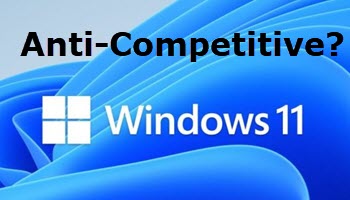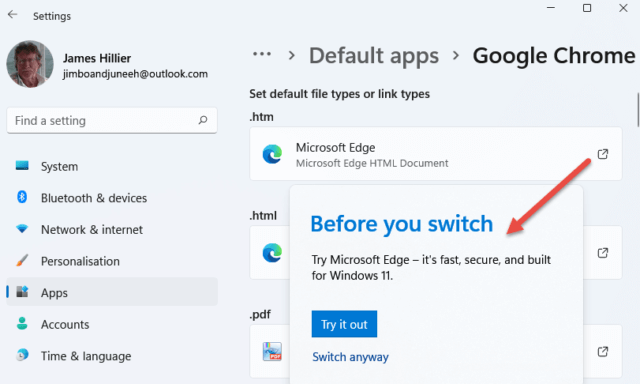You may have read one of the numerous reports across tech sites explaining how Microsoft has made the chore of setting a different browser (other than Edge) as the default browser in Windows 11 a lot more difficult. Setting any browser other than Edge as default in Windows 11 is no longer a simple process with each and every relevant file association needing to be set manually by the user. For anyone who is tech-savvy, it isn’t difficult but definitely convoluted, and for everyday mum and dad users, well I doubt too many would even know where to start.
How To Change The Default Browser In Windows 11
Navigate to Settings > Apps > Default apps and scroll down until you see the name of your preferred browser. Click on the name of the browser and a list of file associations will open. Click the icon at the far right of each item and proceed from there — I didn’t complete the process because I’m happy with Edge anyway but there were 13 file associations that required changing:
Even then not everything will open in your chosen browser — links in locally installed apps, for example, will still open in Edge. Furthermore, the EdgeDeflector extension and similar extensions that have been specifically designed to redirect links from Edge to the default browser have now been blocked by Microsoft.
Bottom line — Microsoft is intent on making it as difficult as humanly possible for users to select a different browser than Edge as 100% default.
Internet Explorer vs Netscape
Those of a certain age would remember the original browser war between Internet Explorer and Netscape. Netscape had dominated the browser market for quite some time until Microsoft decided to integrate its browser into Windows (circa 1996-1997). That move by Microsoft marked the beginning of the end for Netscape. Eventually, the DOJ charged that Microsoft was in contravention of anti-competitive laws (anti-trust) as the company was gaining an unfair advantage by bundling Internet Explorer with Windows. Microsoft was judged guilty as charged but the decision was a hollow victory for Netscape as by then its market share had been decimated to the point of no return.
So, considering a legal precedent has been set, it begs the question… will someone take legal action against Microsoft for this latest anti-competitive behavior? I don’t think so. Microsoft’s wealth and influence have increased massively since those days and I doubt Mozilla or any of the Chromium-based browser developers would have the resources and/or perhaps the courage to take on the Redmond giant. Google, of course, is the exception but, considering Google’s history of anti-competitive behavior, I seriously doubt they’d want to open that can of worms.
A Deliberate Act By Microsoft?
Of course it’s deliberate. One would have to be naïve to think otherwise. Internet Explorer once ruled the browser world and I believe Microsoft is intent on achieving a similar result with Edge, plus it would be a particularly sweet victory for Microsoft to dethrone Google’s Chrome browser.
Windows 11 Debacle
Windows 11 has been a debacle from the beginning:
- Ridiculous requirements that exclude millions of users, including those owning relatively new machines that are perfectly capable of running Windows 11
- Confusing everyone by introducing a previously unheard of mandatory requirement (TPM)
- Decisions that see the deprecation of features and options — e.g., a Taskbar fixed at the bottom of the screen and arguably the worst Start menu ever
- Making the process of setting third-party applications as default — including browsers — a lot more difficult
Here’s the thing — Windows is so dominant in the marketplace with very little in the way of viable competition that users are forced to pretty much accept whatever Microsoft throws at them — and Microsoft knows it. And let’s not lose sight of the fact that Microsoft is not alone with its anti-competitive behavior — both Apple and Google have been at it for years.
Of course, just because others are participating in anti-competitive behavior doesn’t make it right but it does set a trend of unacceptable practices that makes it difficult to single out any one culprit.
—




Thanks Jim
If only the Linux people had decided years ago to be a serious threat to Windows the story could have been so much different. They had their chance in the early nineties and blew it – instead those Geeky types who prefer DOS style commands to actually be able to do anything serious with it refused to let the average layperson in and it so it has remained pretty much a fringe O/S for elitist groups of programmers and nerdy types.
The gaming market is huge worldwide. Imagine if you could run all your games on a stripped down O/S built from the ground up purely for gaming. Once adopted by enough people the gaming houses would quickly ensure their software ran on it and soon there would be the critical mass of people moving away from Microsoft altogether for gaming and many would turn their backs on Windows altogether – because no doubt you could build in options to browse the internet, check your emails and whatever if you so desired albeit at a small performance hit.
Why some rich bugger didn’t invest and fund something like this I’ll never know.
It hasn’t ended with just that. They are now dropping or at least severely reducing security updates for Win 10.
https://www.zdnet.com/article/microsoft-windows-10-is-a-security-disaster-waiting-to-happen/?ftag=TRE5575fdc&bhid=%7B%24external_id%7D&mid=%7B%24MESSAGE_ID%7D&cid=%7B%24contact_id%7D&eh=%7B%24CF_emailHash%7D
Charles, that only applies to Windows 10 after its end-of-support date on 14th October 2025. Perfectly normal.
Also, they have stripped out most of the fonts that you can choose from. THis may not affect everyone that just plays games or writes generic text but for anyone who is creative or does artistic work, it will force you to hunt down all of your favs, and hopefully Win 11 will allow them to be installed.
ZDNET-With rollout of 21H2, Microsoft moves Windows 10 to annual updates
On November 16, Microsoft is starting to roll out Windows 10 21H2, also known as the Windows 10 November 2021 Update. As part of this rollout announcement, officials also are finally providing some answers as to what’s next for Windows 10: It’s moving from a twice-yearly to a once-yearly feature update pace, just like Windows 11 already offers.
The next Windows 10 feature update following 21H2 will be in the second half of 2022, officials said today. And Home and Pro editions of the 21H2 update will get 18 months of support, while Enterprise and Education editions will get 30 months, starting today.
Microsoft is renaming the service option for Windows 10 releases to the “General Availability Channel” starting with the 21H2 update, replacing the current “Semi-Annual Channel” term for servicing options.
https://www.zdnet.com/article/with-rollout-of-21h2-microsoft-moves-windows-10-to-annual-updates/
Possibly I am reading into this more than what it really says?
This is referring to the major feature updates such as 1909, 2004 20H2, 21H1, etc., not the regular security and bug fix updates.